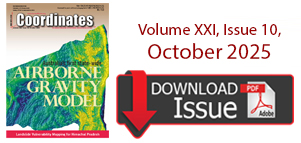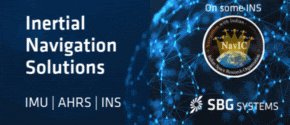| GIS News | |
GIS
Disaster response with satellite technology
Juvare and ICEYE have announced a strategic partnership designed to deliver unprecedented situational awareness and actionable insights to emergency management agencies, insurers, and government organizations worldwide. Through this collaboration, ICEYE’s high-resolution, all-weather satellite solutions will be integrated into Juvare’s industry-leading WebEOC® platform, strengthening Juvare’s position as the System of Record for emergency management. Juvare.com
Pix4D, ProStar partnership
Pix4D and ProStar Holdings have announced a strategic partnership. It combines Pix4D’s advanced 3D modeling capabilities with ProStar’s PointMan® platform to support the next evolution in augmented reality for critical underground infrastructure. This combination will enable users to view a representation of what lies beneath the Earth’s surface in 3D from a smartphone. PointMan’s mobile and cloud-based architecture is designed to precisely capture and map subsurface assets, while Pix4D’s software transforms this data into real time 3D mapping. prostarcorp.com
GEOSA and SLA launch achievements of Joint Geospatial System Project in Singapore
The General Authority for Survey and Geospatial Information (GEOSA) and the Singapore Land Authority (SLA) officially launched the outcomes of their cooperation project to develop and manage the geospatial system. The partnership is part of GEOSA’s broader effort to establish a robust national geospatial infrastructure, aligning with global best practices to enhance the positive and sustainable impact of geospatial data across multiple sectors.
The cooperation serves as a model for effective international collaboration, supporting the integration of geospatial academic, and non-profit sectors, and advancing national development priorities. As part of the project, both parties worked to strengthen ties between the Arab Committee of Experts, chaired by Saudi Arabia, and the UN Asian Committee of Experts on Geospatial Information Management, represented by Singapore. The Arab Committee shared insights on developing geospatial governance and infrastructure, while the Asian Committee contributed its expertise in disaster management and land administration. www.spa.gov.sa
GomSpace adds Neuraspace traffic management to HOOP platform
Denmark’s GomSpace has partnered with Portugal’s Neuraspace to add their space traffic management to its hands-off operations platform (HOOP) for satellite operators. The combination of both will provide improved safety and further cost reduction to GomSpace’s customers.
The partnership also showcases that Neuraspace’s AI-based space traffic management, in addition to enabling operators to directly monitor their assets in orbit and pre-launch screening for rocket starts is ideally suited to be integrated into other service platforms.
HOOP is an advanced satellite operations platform built for automation, scalability and flexibility. Through it, customers can grow their business from the first satellite to a global constellation without having to invest in the operational infrastructure or needing to know how to operate them or care for the day to-day operations. neuraspace.com
Atlas GIS platform receives significant upgrades
Atlas has introduced several new features aimed at simplifying geospatial workflows for teams without requiring coding expertise. The centerpiece of this launch is the Workflows engine, which allows users to visually design and automate spatial analysis processes — such as filtering data, performing calculations and updating layers — without writing code. By streamlining these tasks into automated chains, the feature seeks to reduce the time and effort traditionally spent on repetitive scripting. The Atlas platform offers real-time collaboration and no code solutions for spatial analysis, automation, and app building. atlas.co
EUSI, Albedo to bring 10cm satellite imagery to Europe
European Space Imaging (EUSI) has joined forces with Albedo, the company behind the first commercial satellite designed for Very Low Earth Orbit (VLEO). Together, they aim to deliver the world’s highest-resolution satellite imagery to the European and North African markets, setting a new standard in Earth observation. This announcement follows the successful launch and initial commissioning of Albedo’s Clarity-1 satellite, marking ® INSTITUTE OF NAVIGATION a significant milestone in Earth observation capabilities. albedo.com
Ahmedabad civic body employs GPR tech to map underground utilities ahead of infra projects
With all of the city’s utilities, including power supply lines, going underground, the Ahmedabad Municipal Corporation (AMC) in Gujarat, India has begun using Ground Penetration Radar (GPR) technology to map underground distribution networks to avoid damage and prevent delays in the ongoing work for upcoming projects.
The technology, which is a non-destructive geophysical method that uses radio waves to image the subsurface, allowing for the detection and mapping of underground utilities without excavation, is currently being tried at the Panjrapole crossroads for a flyover project by the civic body.
The non-destructive method that can detect objects up to 10 metres below ground was first put to trial on the Ashram. Road around two years ago for the purpose of microtunneling for a storm water pipeline between Vadaj and Mahalaxmi Society.
In one past instance where the AMC employed its trial pit method for a bridge project, it realised there was a drainage pipeline underneath the chosen location just as digging began. What followed was communication to concerned agencies, approvals, and re alignments that led to avoidable delays.
Similarly, in another microtunneling project, the gas of one of the pipelines and electricity cables got damaged, while in other cases, digging led to cave-ins — all leading to delays, inconvenience to residents and additional costs.
A site where the GPR survey was recently used, though not by AMC, was at the proposed location of the bullet train project area at Sabarmati. Sources revealed that it was used to map the underground f indings in order to prevent damage during construction to depth of up to 10 metres.












 (No Ratings Yet)
(No Ratings Yet)






Leave your response!